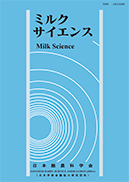All issues

Volume 48 (1999)
- Issue 3 Pages 171-
- Issue 2 Pages 65-
- Issue 1 Pages 1-
Predecessor
Volume 48, Issue 3
Displaying 1-3 of 3 articles from this issue
- |<
- <
- 1
- >
- >|
Review
-
Masayuki Noda1999 Volume 48 Issue 3 Pages 171-180
Published: 1999
Released on J-STAGE: October 31, 2015
JOURNAL FREE ACCESSDownload PDF (2782K)
Original Reports
-
Yasuo Igarashi, Shingo Nakamura1999 Volume 48 Issue 3 Pages 181-186
Published: 1999
Released on J-STAGE: October 31, 2015
JOURNAL FREE ACCESSCasein was precipitated at pH 4.6 from skim milk and washed twice either with deionized water or 10 mM Na phosphate at pH 4.6. The washed casein was dissolved at pH 7.5 and reprecipitated after treatment with or without 2-mercaptoethanol (ME). Amount and composition of protein in washings and supernatants obtained by reprecipitation were examined. The first washing removed protein corresponding to about 10% of that in whey. The results of urea-PAGE showed that the protein originated mostly from residual whey proteins, but γ-caseins were also included in wash water both in the presence and absence of 10 mM Na phosphate. The second washings contained casein components, γ-caseins, κ-casein and β-casein; the proportion of β-casein was higher in the washing with deionized water than with 10 mM Na phosphate. Supernatant fractions obtained by reprecipitation of twice-washed casein contained γ-caseins and a number of fast- and slow-migrating components. Treatment with ME resulted in an increase in the κ-casein level in supernatant. The dissociation of αs1- and β-caseins to supernatant was also apparent when reprecipitated from deionized water. The present results suggest that a part of caseins are lost during washing and the subsequent reprecipitation of acid casein, especially when κ-casein is in its reduced form, and also suggest that a low concentration of phosphate may be effective for minimizing the loss of major caseins.View full abstractDownload PDF (1680K) -
Ayumi Morimoto, Akiyoshi Hosono1999 Volume 48 Issue 3 Pages 187-191
Published: 1999
Released on J-STAGE: October 31, 2015
JOURNAL FREE ACCESSThe objective of this study was to evaluate the contribution of Lactobacillus acidophilus LA2 on the urinary and the fecal IQ (2-amino-3-methylimidazo [4, 5-f] quinoline) excretion. Eight weeks old Wister strain rats were housed in individual cages, in an air-conditioned room where the temperature and humidity were maintained at 22C and at 50 + 5 % were maintained, respectively. The rats were divided into three groups of five each. Each rat was fed 15 g of powdered rat chow containing 1 mg of IQ supplemented 0%, 20%, 40% and 60% milk fermented with L. acidophilus LA2 per day for 7 days. Water was given ad libitum. After one day of the feeding period, samples of feces and urine were collected separately for 2 days at 24 hours intervals. The mutagenicities of these samples were assayed by Ames method using Salmonella typhimurium TA 98 as an indicator bacteria.
Administration of the chow supplemented with milk fermented with L. acidophilus LA-2 showed no effect on fecal IQ excretion. However, the mutagenicity of the urine significantly increased by the administration of the chow supplemented with milk fermented with L. acidophilus LA-2 (p<0.05).View full abstractDownload PDF (898K)
- |<
- <
- 1
- >
- >|